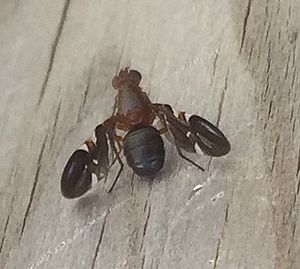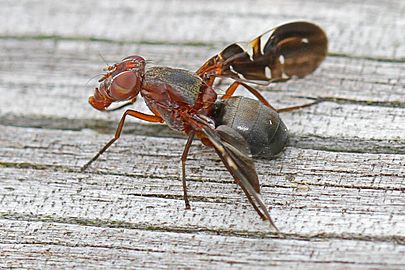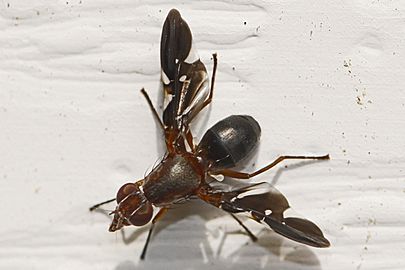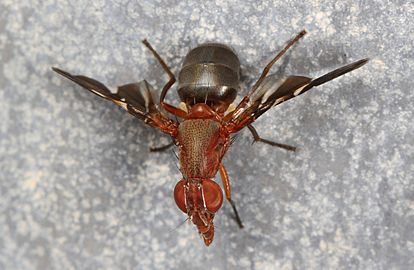Delphinia picta facts for kids
Quick facts for kids Delphinia picta |
|
|---|---|
 |
|
| Scientific classification | |
| Genus: |
Delphinia
|
| Species: |
picta
|
| Synonyms | |
|
|
The Delphinia picta is a special kind of fly. It belongs to a group called Ulidiidae, known as picture-winged flies. Its name, picta, comes from Latin and means "painted." This is because of the cool patterns on its wings!
This fly is the only species in its entire group, called Delphinia. You can find D. picta in the United States, especially along the East Coast and in the Midwest. They live from Florida all the way up to Maine, and west to Kansas and Minnesota. They also live further south in Mexico and El Salvador.
Sometimes, people confuse D. picta with fruit flies. But D. picta are different because they don't eat living plants. Instead, they are detritivores, which means they eat decaying plant matter. They have even been seen eating fermented waste from certain beetles on black locust trees. You can find these flies almost anywhere there's rotting plants, like landfills, temperate deciduous forests, swamps, and even shaded fields.
Contents
What Does Delphinia picta Look Like?
The easiest way to spot a Delphinia picta is by its unique wings. They are shiny and dark brown with clear, see-through areas. The fly's body is about 7mm long, which is less than half an inch. It has a black lower body, called the abdomen. Its head, middle body (the thorax), and legs are light brown.
Female flies have a special part called an ovipositor, which they use to lay eggs. It's about 1.27mm long. This part has tiny hairs, called setae, and its tip bends slightly downwards.
Life Cycle of the Delphinia picta
Adult D. picta flies usually live for less than 40 days in a lab. However, some can live up to 69 days. Mating happens in the evening, about two days after the flies become adults.
During courtship, the female gently waves her wings. The male responds by flicking his wings. Sometimes, both the male and female will blow a small bubble from their mouths!
After mating, a female can lay up to 500 eggs. She lays them in decaying plant material. The eggs hatch into larvae (like tiny worms) in 4 to 6 days. These larvae grow through three stages. They become pupae in 21 to 30 days. Then, they finish changing into adult flies 14 to 17 days later.
The amount of daylight affects how fast they grow. D. picta is a multivoltine species. This means they have more than one generation each year. One group grows from May to July. Another group spends the winter as mature larvae before becoming adults in the spring.
Where Delphinia picta Lives and What Eats It
Delphinia picta flies are often found near certain plants. These include the black locust tree (Robinia pseudoacacia), the eastern cottonwood tree (Populus deltoides), and the saw palmetto plant (Serenoa repens).
These flies can also be prey for other insects. For example, certain wasps, like Crabro monticola, hunt and eat Delphinia picta.
Gallery
Images for kids





